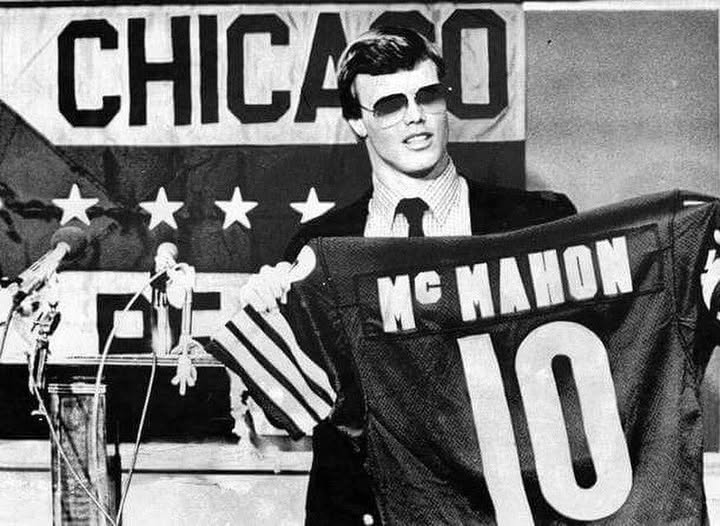The Chicago Bears, one of the oldest and most storied franchises in the National Football League, took a bold step toward reshaping their future with the fifth overall pick in the 1982 NFL Draft. On that day, they selected quarterback Jim McMahon out of Brigham Young University (BYU), a decision that would forever alter the direction of the franchise. While he wasn’t the most polished passer or the most traditional leader, McMahon embodied a fierce competitiveness and a swagger that would define an era in Chicago sports.
The Selection of a Maverick
Jim McMahon had just wrapped up a spectacular collegiate career at BYU. Known for his unrelenting confidence and uncanny ability to command an offense, McMahon shattered over 70 NCAA records during his time in college. His performance earned him the Davey O’Brien Award and All-American honors, firmly placing him on the radar of NFL scouts.
The Bears, who had struggled with quarterback consistency since the days of Sid Luckman, saw in McMahon a chance to revitalize their offense. Team president Michael McCaskey and head coach Mike Ditka, himself in his first year at the helm, believed McMahon had the personality and toughness to lead a team built around hard-nosed defense and a power run game.
Rookie Year Amidst a Strike
McMahon’s rookie season was unusual. The 1982 season was shortened to nine games due to a players’ strike. Nevertheless, McMahon made an immediate impact. Though not the starter at the beginning, he quickly took control of the huddle and became known for his fearless approach, both on and off the field. He threw for 1,501 yards and nine touchdowns in seven starts, giving Bears fans a glimpse of what was to come.
Building a Contender
As McMahon matured, so did the Bears roster. Running back Walter Payton remained the cornerstone of the offense, but McMahon brought a sense of unpredictability. His improvisation skills complemented Payton’s disciplined excellence. On defense, legends like Mike Singletary, Richard Dent, Dan Hampton, and Wilber Marshall formed one of the most feared units in NFL history.
By the 1984 season, the Bears were evolving into contenders. McMahon, though often injured, displayed leadership and guts. His signature headbands and sarcastic quotes made headlines, but it was his toughness that won over teammates and fans. He played through pain and didn’t shy away from conflict, be it with opponents or even NFL commissioner Pete Rozelle.
The 1985 Season: A Legacy Cemented
The 1985 season remains the zenith of Chicago Bears history. With McMahon as the quarterback, the Bears roared to a 15-1 regular-season record. McMahon, though plagued by injuries, was the heart and soul of the offense. His leadership was visible in his resilience—most notably when he came off the bench against the Minnesota Vikings and threw three touchdown passes in a matter of minutes.
The Bears stormed through the playoffs, shutting out both the Giants and the Rams to reach Super Bowl XX. There, they dismantled the New England Patriots 46-10 in one of the most lopsided championship games ever. McMahon ran for two touchdowns and passed with poise, while the defense annihilated anything in its path. The Bears were not just winners—they were a cultural phenomenon.
McMahon’s personality helped define the team’s identity. His refusal to conform, his unapologetic brashness, and his disdain for authority were refreshing in a league often known for rigid professionalism. He became the perfect face for a team that wore its attitude like a badge of honor.
Injuries and Controversy
Unfortunately, McMahon’s career was marred by injuries. His daring style made him susceptible to hits, and a series of shoulder and back problems limited his ability to stay on the field. Despite his clear talent, he never played a full 16-game season for the Bears. The front office, frustrated by his durability and sometimes combative nature, often clashed with McMahon behind closed doors.
By 1988, after several seasons of ups and downs, McMahon was traded to the San Diego Chargers. His time in Chicago was over, but the mark he left was indelible. He would go on to have stints with other NFL teams, including the Philadelphia Eagles, Minnesota Vikings, Arizona Cardinals, and eventually as a backup with the Green Bay Packers—ironically winning a second Super Bowl ring with Chicago’s most bitter rival in 1996.
A Chicago Icon
Despite the tumultuous end to his Bears career, McMahon remains a beloved figure in Chicago. His Super Bowl-winning leadership, anti-establishment attitude, and warrior-like mentality captured the city’s heart. He wasn’t just a quarterback; he was a symbol of the 1980s Bears—unapologetically tough and defiantly proud.
He embodied the working-class spirit of the city. Whether he was wearing sunglasses during a press conference or tossing a touchdown pass in the freezing cold, McMahon represented more than stats. He was heart, grit, and determination.
Legacy and Reflection
In the years following his retirement, McMahon has been outspoken about the long-term effects of football on his health, particularly concussions. He’s become an advocate for player safety and medical reform within the NFL. His honesty about his struggles has only deepened the respect many fans and former players have for him.
Looking back, the decision the Bears made in 1982 to draft Jim McMahon was about more than just finding a quarterback. It was about changing the DNA of a team and a city. For a few magical years, McMahon gave Chicago exactly what it needed: a winner with attitude.
Today, his name is etched in Bears lore, not just for the championship, but for the way he won it. He may not be in the Hall of Fame, but he’s in the hearts of every Chicagoan who lived through the glory days of 1985.
The rest is, truly, Chicago’s history.



